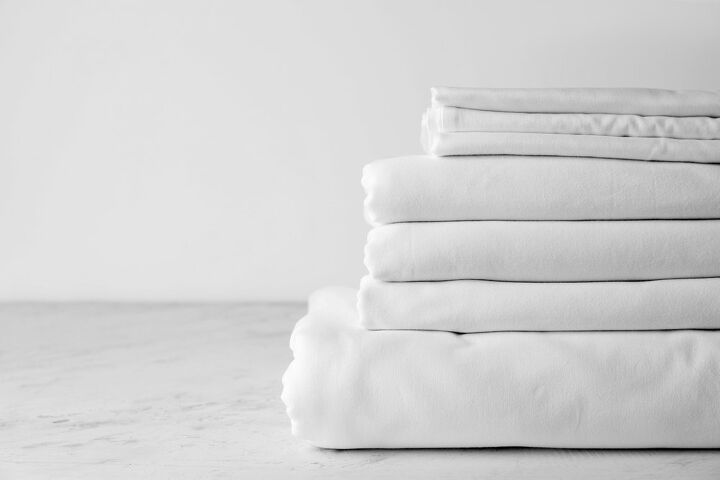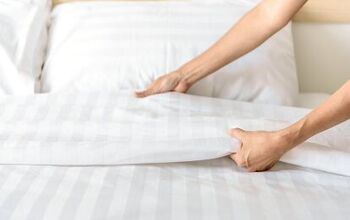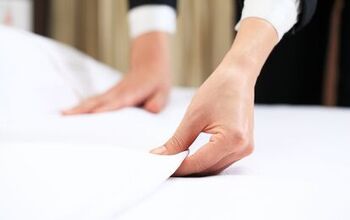How To Get Gum Out Of Sheets

At some point in our lives, we’ve all had the horror of gooey gum falling on and attaching to our clothing, bedsheets, or maybe you have kiddos, and they seem to get it everywhere. Regardless, we’ve all fallen asleep with gum in our mouths at some point. You considered yourself lucky if the gum sat on the top of the sheet, but what happens if it gets stuck in it?
To get gum out of your sheets, put your sheets in the freezer for an hour to harden the gum. After the gum is solidified, scrape the gum off using a spatula or your fingers, ensuring all gum residue is gone. Then, use white vinegar to get the stain out of the sheets before throwing them in the washer.
Let us show you how to get bubblegum out of your bed linens using a variety of methods, including the freezing method, as well as white spirit, vinegar, cooking oil, and peanut butter. Let’s get started!
How Do You Remove Gum From Your Sheets?
Having this chewing gum clinging to the fabric used to mean you would need to throw away your sheets, blankets, clothing, or whatever it was that the gum got stuck to.
Thankfully, though, there have been methods created to help you altogether remove gum and any leftover stains from it.
The best part about this is that it is entirely free! You most likely have everything that you need in order to start the process. If you don’t, it’s only a few bucks.
Important: Always read the label and care instructions placed on the fabric of your clothing before beginning any chewing gum cleaning procedures.
Use Your Freezer Or Some Ice Cubes
This method is one of the most well-known, so you might have heard of it. It’s beneficial in a variety of situations. Below, we will take you through the steps to teach you how to use ice or your freezer to remove gum from your sheets.
Step 1: Put Your Sheets In The Freezer
Fold your bed linens so that they will fit into the freezer first. Understand that bubblegum should be exposed, which means it should be on the outside of the cloth you’re working on. Make sure the gum is exposed, with no other bits of paper or fabric covering it.
Allow your cloth to remain in the freezer for as long as necessary to freeze the gum. It usually takes about an hour for the gum to set. If you don’t have access to a freezer or the bed sheets are too large, use an ice pack instead.
To use the ice pack, softly rub the gum with a bundle of ice cubes. Then place the ice pack over the gum and keep it there for about 45 minutes, or as long as necessary, until the gum solidifies.
Step 2: Scrape
You may easily pry the gum off once it has frozen, hardened, and is no longer sticky. To easily remove gum in this stage, take a spatula—or your fingernails—and carefully lift and scrape as much gum as you can off the fabric.
After you’ve removed most of the gum, carefully wipe away the extra bits with a butter knife. Don’t use any tools that are too sharp, and make sure you scrape gently—you’re trying to save your fabric from additional damage, not destroy it more.
Step 3: Get the Stain Out
Even if you cleaned the gum away, there would almost certainly be a stain left behind. In this situation, grab a sponge and soak it in white vinegar before blotting the gum stain.
Then you’ll need to check the fabric once more. Is there any stain remnant left on your bed sheets’ sensitive fabrics? If so, then wipe the fabric once more, and repeat as needed until the stain is entirely gone.
Step 4: Throw Your Sheets in the Washer
It’s time to clean your bed sheets after removing the gum and eradicating the discoloration. Again, you always check the care label recommendations for the sheets you’re cleaning.
Before dumping the stained sheets into the washer, rub them with detergent or stain remover to boost the washing effect.
After you’ve washed the sheets, double-check to see if the stain has vanished. If it does, you can leave it to air dry. If the stain persists despite your efforts, go back and revisit the 3rd and 4th steps.
Will Lemon Juice Remove Gum From Linens?
Lemon juice, like baking soda, has a variety of applications, and many of them are related to cleaning. And yes! You can use lemon juice to remove gum from your bedsheets, clothing, or couch cushions.
All you need to do is dip the cloth with the piece of gum facing toward the lemon juice. Once you’ve let it soak for a few minutes, use a spatula and gently scrape away the gum.
Afterward, you will want to wash your bed linens as you usually do. However, this method isn’t excellent for white sheets, as the lemon juice has a slight yellowish tint.
Can You Use White Vinegar to Remove Gum From Your Linens?
White vinegar can be used in the same way that baking soda and lemon juice are used. If you wish to eliminate gum and anything it’s left behind, then this kitchen-made treatment will be as effective. This household’s versatile hero will manage the problem efficiently in just a few simple steps:
- Boil your vinegar (yes, it will stink). In a small pot, bring the vinegar to a boil.
- Scrub the gum and stains. Dip a toothbrush in hot water and scrub the affected area. This method can be used on carpets, clothing, and couches as well.
- Let it sit. Some individuals recommend fully submerging the gummy region into the hot vinegar for two to three minutes. Others recommend leaving it to soak for many hours or even longer.
- Scrub the gum again. With a bit of elbow grease, the gum should easily come out.
Which is Better at Removing Gum: Vinegar or Lemon Juice?
Overall, you must submerge the gum in one of the above-mentioned solutions and allow it to soak in both circumstances.
Soak the gum for several hours or overnight, depending on how bad it is stuck in your sheets. After that, you ought to be able to scrape or sweep the gum away with ease, no matter which method you use.
Always remember to wash the fabric in cold water so that you can lessen the chances of any stains. And yes, oddly enough, white vinegar can stain!
Will Oil Remove Gum From Fabric?
We realize that the thought of using oil to remove gum might make you cringe, as this solution appears strange at first. We’ve been attempting to eliminate the greasy stains throughout the article, so why would we put any oils on our precious fabric on purpose now?
As a result, oil does not cause the gum to harden, unlike other treatments. It makes it softer! You can use the most common types of oil, such as cooking oil, but mayonnaise and peanut butter work just as well!
However, again, you want to make sure you’re paying attention to the color of your sheets before choosing a method. For example, don’t use brown peanut butter on white silk.
How Do You Use Oil To Remove Gum From Your Linens?
To use oil in removing gum, you will want to gently massage the gum all over with the oil of your choosing.
Then, wipe it off the fabric using your fingertips or a spatula. Make sure that you also wipe up all residual oil using a cloth towel or paper towel.
After this, you will want to toss your sheets in the washer immediately to avoid any additional staining from the oil.
If you’re unsure how oil may affect your cloth, try another option (e.g., if the fabric is delicate). Experimenting with your favorite bed sheets isn’t worth it!
Does Duct Tape Help Remove Gum From Fabric?
If you’ve ever heard of ‘fighting fire with fire,’ you might understand why duct tape can help remove gum from fabric. Instead of duct tape, you can also use more chewing gum. It sounds weird, but it’s true!
Here’s how to use duct tape or another chewed piece of gum to its full potential:
All you have to do is attach your duct tape or gum to the stuck-on gum and peel it off. If you decide to use more gum, be careful not to adhere it to more fabric in the surrounding area.
The fresh gum or duct tape stickiness will help stick to the stuck-on gum. Then, when you peel it off, it should help remove the remnants in the fibers. Afterward, use one of the above methods to pull out any stains, and then toss your sheets in the washer!

Heather is a passionate writer who loves anything DIY. Growing up, she learned everything from home repairs to design, and wants to share her tips with you. When she's not writing, she's usually hiking or searching for her next DIY project.
More by Heather Robbins


























